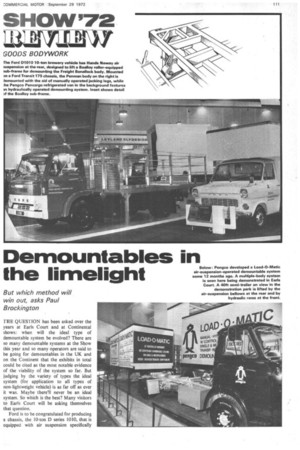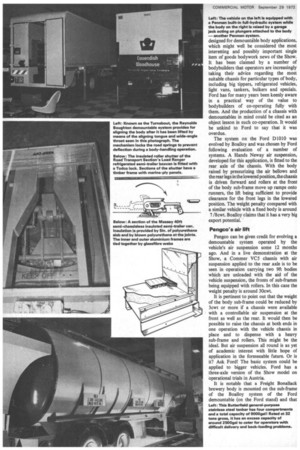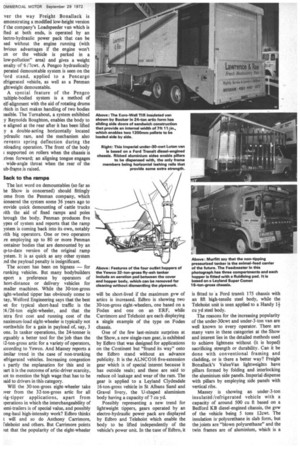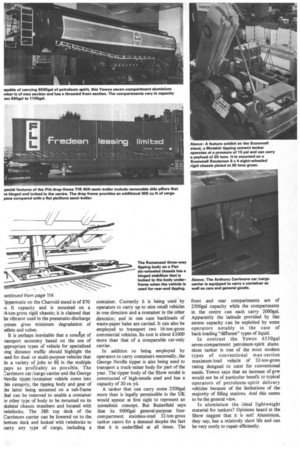Demountables in the limelight
Page 393

Page 394

Page 395

Page 396

Page 399

If you've noticed an error in this article please click here to report it so we can fix it.
But which method will win out, asks Paul Brockington
THE QUESTION has been asked over the years at Earls Court and at Continental shows: when will the ideal type of demountable system be evolved? There are so many demountable systems at the Show this year and so many operators are said to be going for demountables in the UK and on the Continent that the exhibits in total could be cited as the most notable evidence of the viability of the system so far, But judging by the variety of types the ideal system (for application to all types of non-lightweight vehicle) is as far off as ever it was. Maybe there'll never be an ideal system. So which is the best? Many visitors to Earls Court will be asking themselves that question.
Ford is to be congratulated for producing Et chassis, the 10-ton D series 1010, that is equipped with air suspension specifically designed for demountable body applications, which might well be considered the most interesting and possibly important single item of goods bodywork news of the Show. It has been claimed by a number of bodybuilders that operators are increasingly taking their advice regarding the most suitable chassis for particular types of body, including big tippers, refrigerated vehicles, light vans, tankers, bulkers and specials. Ford has for many years been keenly aware in a practical way of the value to bodybuilders of co-operating fully with them. And the production of a chassis with demountables in mind could be cited as an object lesson in such co-operation. It would be unkind to Ford to say that it was overdue.
The system on the Ford D1010 was evolved by Boalloy and was chosen by Ford following evaluation of a number of systems. A Hands Neway air suspension, developed for this application, is fitted to the rear axle of the chassis. With the body raised by pressurizing the air bellows and the rear legs in the lowered position, the chassis is driven forward and rollers at the front of the body sub-frame move up ramps onto runners, the lift being sufficient to provide clearance for the front legs in the lowered position. The weight penalty compared with a similar vehicle with a fixed body is around 7 /8cwt. Boalloy claims that it has a very big export potential.
Perigco's air lift
Pengco can be given credit for evolving a demountable system operated by the vehicle's air suspension some 12 months ago. And in a live demonstration at the Show, a Commer VC5 chassis with air suspension applied to the rear axle is to be seen in operation carrying two 9ft bodies which are unloaded with the aid of the vehicle suspension, the fronts of sub-frames being equipped with rollers. In this case the weight penalty is around 30cwt.
It is pertinent to point out that the weight of the body sub-frame could be reduced by 3cwt or more if a chassis were available with a controllable air suspension at the• front as well as the rear. It would then be possible to raise the chassis at both ends in one operation with the vehicle chassis in place and to dispense with a heavy sub-frame and rollers. This might be the ideal. But air suspension all round is as yet of academic interest with little hope of application in the foreseeable future. Or is it? Ask Ford! The basic system could be applied to bigger vehicles. Ford has a three-axle version of the Show model on operational trials in Austria.
It is notable that a Freight Bonallack brewery body is mounted on the sub-frame of the Boalloy system of the Ford demountable (on the Ford stand) and that ver the way Freight Banallack is emonstrating a modified low-height version f the company's Loadspeeder van which is fled at both ends, is operated by an lectro-hydraulic power pack that can be sed without the engine running (with bvious advantages if the engine won't an or the vehicle is parked in a low-pollution" area) and gives a weight enalty 'of-6 /7cwt. A Pengco hydraulically perated demountable system is seen on the
■ ord stand, applied to a Pencargo efrigerated vehicle, as well as a Penman ghtweight demountable.
A special feature of the Pengco lultiple-bodied system is a method of elf-alignment with the aid of rotating drums /filch in fact makes handling of two bodies msible. The Turnabout, a system exhibited y Reynolds Boughton, enables the body to e aligned at the rear after it has been lifted y a double-acting horizontally located ydraulic ram, and the mechanism also revents spring deflection during the nloacling operation. The front of the body ; supported on rollers when the chassis is riven forward; an aligning tongue engages wide-angle throat when the rear of the ub-frarne is raised.
3ack to the ramps
The last word on demountables (so far as he Show is concerned) should fittingly ome from the Penman company, which lioneered the system some 36 years ago to provide quick demounting of cattle trucks eith the aid of fixed ramps and poles hrough the body. Penman produces five ypes of system and reports that the ramp ystem is coming back into its own, notably vith big operators. One or two operators re employing up to 80 or more Penman ontainer bodies that are demounted by an p-to-date version of the original ramp ystem. It is as quick as any other system nd the payload penalty is insignificant.
The accent has been on bigness — for runking vehicles. But many bodybuilders eport a preference by operators of hort-distance or delivery vehicles for mailer machines. While the 30-ton-gross ight-wheeled tipper has obviously come to tay, Welford Engineering says that the best tet for typical short-haul traffic is the 4/26-ton eight-wheeler, and that the octra first cost and running cost of the naximum-load eight-wheeler is typically not vorthwhile for a gain in payload of, say, 3 ons. In tanker operations, the 24-tonner is trguably a better tool for the lob than the 12-ton-gross attic for a variety of operators, tccording to Yewco. And Massey reports a imilar trend in the case of non-trunking efrigerated vehicles. Increasing congestion s partly the explanation for this and in tart it is the outcome of artic-driver scarcity, tot to mention the high wage that has to be mid to drivers in this category.
Will the 30-ton-gross eight-wheeler take wer from the 32-ton-gross attic for all tig-tipper applications, apart from Terations in which the interchangeability of emi-trailers is of special value, and possibly ong-haul high-intensity work? Edbro thinks I will and so do Anthony Carrimore, Celehoist and others. But Carrimore points tut that the popularity of the eight-wheeler will be short-lived if the maximum gvw of attics is increased. Edbro is showing two 30-ton-gross eight-wheelers, one based on a Foden and one on an ERF, while Carrimore and Telehoist are each displaying a single example of the type on Foden chassis.
One of the few last-minute surprises at the Show, a new single-ram gear, is exhibited by Edbro that was designed for applications on the Continent but "found its way" onto the Edbro stand without an advance publicity. It is the ALNC016 five-extension gear which is of special interest because it has outside seals; and these are said to reduce oil leakage and wear of the ram. The gear is applied to a Leyland Clydesdale 16-ton-gross vehicle in St Albans Sand and Gravel livery, the U-shaped aluminium body having a capacity of 7 cu yd.
Possibly representing a new trend for lightweight tippers, gears operated by an electro-hydraulic power pack are displayed by Edbro and Telehoist which enable the body to be lifted independently of the vehicle's power unit. In the tase of Edbro, it
is fitted to a Ford transit 175 chassis with an 8f1 high-tensile steel body, while the Telehoist unit is seen applied to a Handy 1 cu yd steel body.
The reasons for the increasing popularity of the under-30cwt and under-3-ton van are well known to every operator. There are many vans in these categories at the Show and interest lies in the detailed methods used to achieve lightness without (it is hoped) sacrificing strength or durability. Can it be done with conventional framing and cladding, or is there a better way? Freight Bonallack's ValueVan lightweights have pillars formed by folding and interlocking the aluminium side panels. Imperial dispense with pillars by employing side panels with vertical ribs.
Massey is showing an under-3-ton insulated/refrigerated vehicle with a capacity of around 500 cu ft based on a Bedford KB diesel-engined chassis, the gvw of the vehicle being 5 tons 12cwt. The insulation is polyurethane in slab form, but the joints are "blown polyurethane" and the twin frames are of aluminium, which is a type of construction used for larger vehicles. An Imperial ribbed-aluminium under-30cwt Luton van is based on a Ford Transit 175 diesel-engined chassis/cab and has a capacity of 550 cu ft. Many types of under-30cwt and under-3-ton van are on view.
Makers of refrigerated bodies are hopefully confident that legislation will be brought in that will make the use of an approved type of body obligatory for carrying meat and other types of perishable food including cream buns, as is the case in some European countries. Heatwaves can play havoc with hygiene, which is a problem anyway. Many operators take a chance on it not happening and carry at a cut rate.
Bonallack Refrigerated Vehicles use the rather grandiose term "controlled environment" in describing the overall requirement of top-fussy traders for transporting their goods and instance Marks and Spencer as a very notable example. A Bonallack Coldsaver 40ft aluminium artic with M and S livery provides temperature control t within close limits of Ideg C, a specik feature of the materials used being th application of a baked acrylic finish to th interior as well as the exterior panels, whic is cited as a very big advance in refrigerate vehicle development because of the eat with which the panels can be ckanec Temperature control is provided by twin-tank liquid-nitrogen unit which] Bonallack claims, is particularly suitable fc the type of store-delivery work on which th vehicle will be engaged. It gives a rapi temperature pull-down time and eliminate the noise problem. The polyurethan insulation is in slab form, which Bonallac prefers to foamed insulation because it density is invariably uniform.
The prospect of date marking am shelf-life marking of cooked meats an other perishable foods is cited by Silverdal as an influence that could foster th increased use of insulated irefrigerato vehicles in place of insulated types (whiel can retain the heat following a ternperatur rise) as temperature control would in th event become a necessary part of the overal production /distribution pattern. Silverdal claims that the continuous glassfibre interio lining of the company's 40ft all-gluo insulated van is the best for hygiene becaus it is non-absorbent, is easily cleaned and (o special importance) is resistant to damage.
Promoting hygiene York also looks forward to stricte control of perishable goods in transit am emphasizes the need for features tha promote hygiene. The company's neN Freightmaster 40ft refrigerated van is lino with glassfibre sheets having a white ge coat, while Plastibloc duckboards are lait on the floor to provide air circulation, whicl are preferred to an aluminium reefer floor Currently Plastibloc is imported; having thickness of lfin. the boards are easih removable to enable pallets to be carrio and their weight is minimal. Thinner board could be used if loading height were critical.
The non-tipping/pressurized type o animal feed bulk-delivery vehicle has bee] said to have one advantage and on advantage only over the tipping type wit] rotary seal discharge, namely (in torn applications) its low loading height. Murfit makes both types and claims that th pressurized tanker with multiple compart ments has a bigger future. Advantage claimed for the company's Feedmaste three-compartment 16-ton-gross tanke include a reduced number of working part compared with a tipping vehicle, a quicke turnround, easier servicing and a facility fo carrying different loads in eacl compartment. The material is discharge from hoppers, each of which is equippo with a fluidizing system.
According to Charrold technicians then is no evidence of a trend towards pressun tankers which, they point out, need a moo specialized loading system, cannot earn backloads of sacks and so on and are moo likely to give mechanical trouble. The emphasize that the value of versatility i; likely to increase, not decrease.
'ippermatic on the Charroid stand is of 870 u ft capacity and is mounted on a 4-ton-gross rigid .chassis; it is claimed that he vibrator used in the pneumatic-discharge ;ystem gives minimum degradation of )ellets and cubes. It is perhaps inevitable that a concept of rampart economy based on the use of ippropriate types of vehicle for specialized ong distance traffic should highlight the seed for dualor multi-purpose vehicles that Jo a variety of jobs to fill in the multiple ;aps as profitably as possible. The 'Carrimore car /cargo carrier and the George Neville tipper/container vehicle come into :his category, the tipping body and gear of :he latter being mounted on a sub-frame :hat can be removed to enable a container ar other type of body to be mounted on its 3ke1etal chassis members and located with twistlocks. The 38ft top deck of the Carrimore carrier can be lowered on to the bottom deck and locked with twistlocks to carry any type of cargo, including a
container. Currently it is being used by operators to carry up to nine small vehicles in one direction and a container in the other direction; and in one case backloads of waste-paper bales are carried. It can also be employed to transport two 16-ton-gross commercial vehicles. Its cost is about £1000 more than that of a comparable car-only carrier.
In addition to being employed by operators to carry containers seasonally, the George Neville tipper is also being used to transport a truck-mixer body for part orthe year. The tipper body of the Show model is constructed of high-tensile steel and has a capacity of 20 cu yd.
A tanker that can carry some 2500ga1 more than is legally permissible in the UK would appear at first sight to represent an unrealistic concept. But Butterfield says that its 9000gal general-purpose fourcompartment stainless-steel 32-ton-gross tanker caters for a demand despite the fact that it is underfilled at all times. The front and rear compartments are of 2500ga1 capacity while the compartments in the centre can each carry 2000gal. Apparently the latitude provided by this excess capacity can be exploited by some operators notably in the case of back-loading "different" types of liquid.
In contrast the Yewco 6550gal seven-compartment petroleum-spirit aluminium tanker is one of the most modern types of conventional max-section maximum-load vehicle of 32-ton-gross rating designed to cater for conventional needs. Yewco says that an increase of gvw would not be of particular benefit to typical operators of petroleum-spirit delivery vehicles because of the limitations of the majority of filling stations. And this seems to be the general view.
Is aluminium the ideal lightweight material for tankers? Opinions heard at the Show suggest that it is not! Aluminium, they say, has a relatively short life and can be very costly to repair efficiently.
































































































































































































































































































































































































































































































































